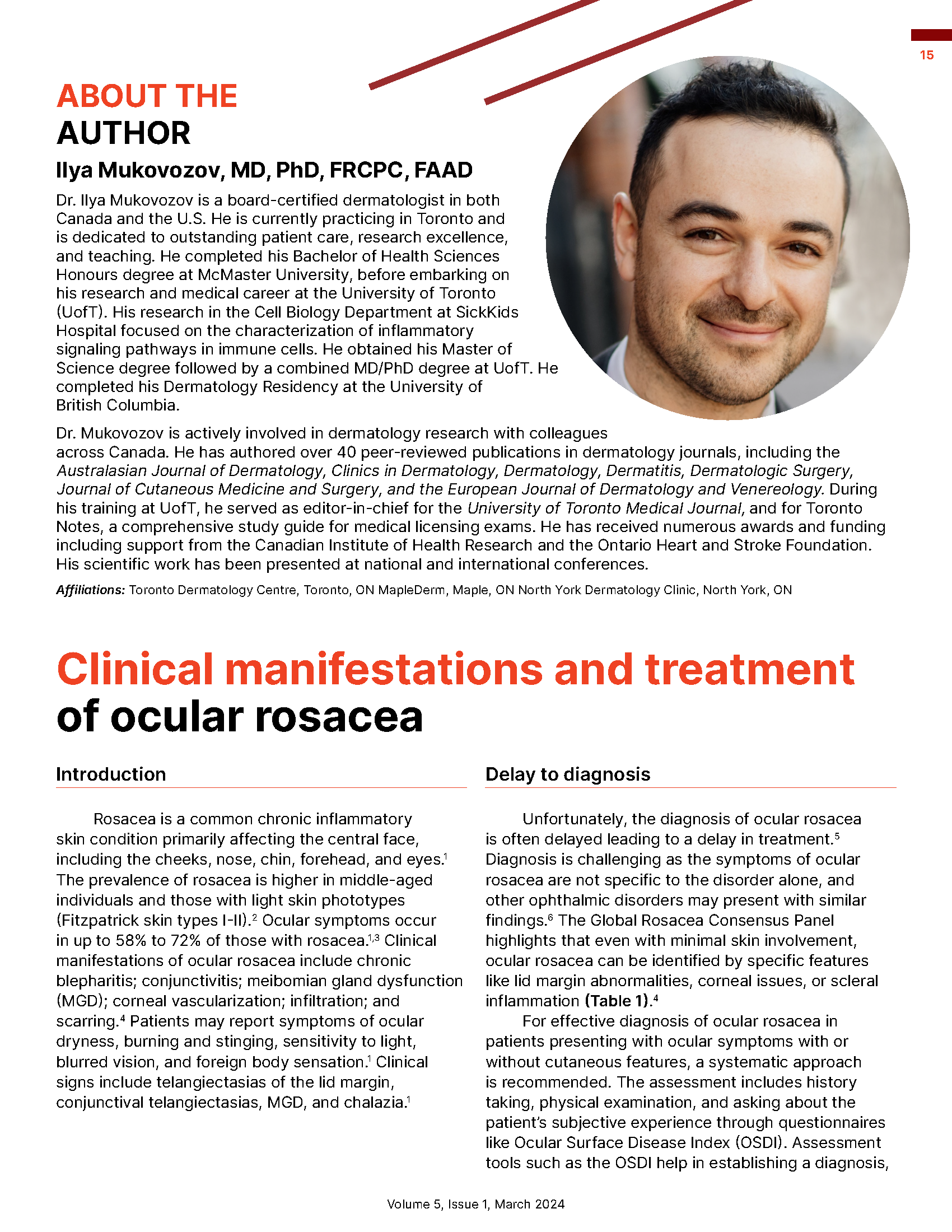Clinical Manifestations and Treatment of Ocular Rosacea
Abstract
Rosacea is a common chronic inflammatory skin condition primarily affecting the central face, including the cheeks, nose, chin, forehead, and eyes. The prevalence of rosacea is higher in middle-aged individuals and those with light skin phototypes (Fitzpatrick skin types I-II). Ocular symptoms occur in up to 58% to 72% of those with rosacea. Clinical manifestations of ocular rosacea include chronic blepharitis; conjunctivitis; meibomian gland dysfunction (MGD); corneal vascularization; infiltration; and scarring. Patients may report symptoms of ocular dryness, burning and stinging, sensitivity to light, blurred vision, and foreign body sensation. Clinical signs include telangiectasias of the lid margin, conjunctival telangiectasias, MGD, and chalazia.
References
Thiboutot D, Anderson R, Cook-Bolden F, et al. Standard management options for rosacea: The 2019 update by the National Rosacea Society Expert Committee. J Am Acad Dermatol. 2020 Jun;82(6):1501-1510.
Rainer BM, Kang S, Chien AL. Rosacea: Epidemiology, pathogenesis, and treatment. Dermatoendocrinol. 2017 Oct 2024 4;9(1):e1361574.
Browning DJ, Proia AD. Ocular rosacea. Surv Ophthalmol. 1986 Nov-Dec;31(3):145-58.
Schaller M, Almeida LMC, Bewley A et al. Recommendations for rosacea diagnosis, classification and management: update from the global ROSacea COnsensus 2019 panel. Br J Dermatol. 2020 May;182(5):1269-1276.
Khaslavsky S, Starkey SY, Avraham S, Kashetsky N et al. Treatment of pediatric ocular rosacea: A systematic review. Ann Dermatol Venereol. 2023 Sep;150(3):199-201.
Vieira AC, Mannis MJ. Ocular rosacea: common and commonly missed. J Am Acad Dermatol. 2013 Dec;69(6 Suppl 1):S36-41.
Khadamy J. Ocular rosacea: don’t forget eyelids and skin in the assessment of this stubborn ocular surface disease. Cureus. 2024 Jan 1;16(1):e51439.
Quarterman MJ, Johnson DW, Abele DC et al. Ocular rosacea: signs, symptoms, and tear studies before and after treatment with doxycycline. Arch Dermatol. 1997;133(1):49–54.
Ghanem VC, Mehra N, Wong S et al. The prevalence of ocular signs in acne rosacea: comparing patients from ophthalmology and dermatology clinics. Cornea. 2003 Apr;22(3):230-3.
Avraham S, Khaslavsky S, Kashetsky N et al. Treatment of ocular rosacea: a systematic review. J Dtsch Dermatol Ges. 2024 Jan 20.
Alghamdi YA, Camp A, Feuer W et al. Compliance and subjective patient responses to eyelid hygiene. Eye Contact Lens. 2017 Jul;43(4):213-217.
Lindsley K, Matsumura S, Hatef E et al. Interventions for chronic blepharitis. Cochrane Database of Systematic Reviews 2012, Issue 5. Art. No.: CD005556.
Craig JP, Blades K, Patel S. Tear lipid layer structure and stability following expression of the meibomian glands. Ophthalmic Physiol Opt. 1995 Nov;15(6):569-74.
Arman A, Demirseren DD, Takmaz T. Treatment of ocular rosacea: comparative study of topical cyclosporine and oral doxycycline. Int J Ophthalmol. 2015 Jun 18;8(3):544-9.
Perry HD, Doshi-Carnevale S, Donnenfeld ED et al. Efficacy of commercially available topical cyclosporine A 0.05% in the treatment of meibomian gland dysfunction. Cornea. 2006 Feb;25(2):171-5.
Stevenson D, Tauber J, Reis BL. Efficacy and safety of cyclosporin A ophthalmic emulsion in the treatment of moderate-to-severe dry eye disease: a dose-ranging, randomized trial. The Cyclosporin A Phase 2 Study Group. Ophthalmology. 2000 May;107(5):967-74.
Andrade FMX, Picosse FR, Cunha LPD et al. Ocular surface changes in the treatment of rosacea: comparison between low-dose oral isotretinoin and doxycycline. Arq Bras Oftalmol. 2020 Mar-Apr;83(2):109-112.
Bilgin B, Karadag AS. Effects of combined oral doxycycline and topical cyclosporine treatment on ocular signs, symptoms, and tear film parameters in rosacea patients. Arq Bras Oftalmol. 2018 Nov./Dec.;81(6):466-470.
Gonser LI, Gonser CE, Deuter C et al. Systemic therapy of ocular and cutaneous rosacea in children. J Eur Acad Dermatol Venereol. 2017 Oct;31(10):1732-1738.
Valentín S, Morales A, Sánchez JL et al. Safety and efficacy of doxycycline in the treatment of rosacea. Clin Cosmet Investig Dermatol. 2009 Aug 12;2:129-40.
Léoni S, Mesplié N, Aitali F et al. Le métronidazole, alternative thérapeutique des rosacées oculaires et cutanées de l’enfant [Metronidazole: alternative treatment for ocular and cutaneous rosacea in the pediatric population]. J Fr Ophtalmol. 2011 Dec;34(10):703-10.
Del Rosso JQ, Brantman S, Baldwin H. Long-term inflammatory rosacea management with subantibiotic dose oral doxycycline 40 mg modified-release capsules once daily. Dermatol Ther. 2022 Jan;35(1):e15180.
van der Linden MMD, van Ratingen AR, van Rappard DC et al. DOMINO, doxycycline 40 mg vs. minocycline 100 mg in the treatment of rosacea: a randomized, single-blinded, noninferiority trial, comparing efficacy and safety. Br J Dermatol. 2017 Jun;176(6):1465-1474.
Holzchuh F G, Hida RY, Moscovici BK et al. (2011). Clinical treatment of ocular Demodex folliculorum by systemic ivermectin. Am J Ophthalmol. 2011 Jun;151(6):1030-1034. e1.
Brown M, Hernández-Martín A, Clement A et al. Severe demodexfolliculorum-associated oculocutaneous rosacea in a girl successfully treated with ivermectin. JAMA Dermatol. 2014;150(1):61–63.
Choi Y, Eom Y, Yoon EG, Song JS et al. Efficacy of topical ivermectin 1% in the treatment of demodex blepharitis. Cornea. 2022 Apr 1;41(4):427-434.
Schaller M, Kemény L, Havlickova B et al. A randomized phase 3b/4 study to evaluate concomitant use of topical ivermectin 1% cream and doxycycline 40-mg modifiedrelease capsules, versus topical ivermectin 1% cream andplacebo in the treatment of severe rosacea. J Am Acad Dermatol. 2020 Feb;82(2):336-343.
Ávila MY, Martínez-Pulgarín DF, Rizo Madrid C. Topical ivermectin-metronidazole gel therapy in the treatment of blepharitis caused by Demodex spp.: A randomized clinical trial. Cont Lens Anterior Eye. 2021 Jun;44(3):101326.
Toyos R, McGill W, Briscoe D. Intense pulsed light treatment for dry eye disease due to meibomian gland dysfunction; a 3-year retrospective study. Photomed Laser Surg. 2015 Jan;33(1):41-6.
Qin G, Chen J, Li L et al. Efficacy of intense pulsed light therapy on signs and symptoms of dry eye disease: A meta-analysis and systematic review. Indian J Ophthalmol. 2023 Apr;71(4):1316-1325.
Toyos R, Desai NR, Toyos M et al. Intense pulsed light improves signs and symptoms of dry eye disease due to meibomian gland dysfunction: A randomized controlled study. PLoS One. 2022 Jun 23;17(6):e0270268.


